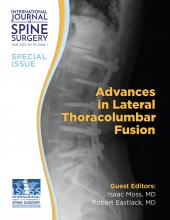The science and practice of interbody fusion surgery has evolved tremendously since it was first reported in the literature in 1953.1 Initial innovation was aimed at the development of interbody fusion devices delivered through traditional open approaches. At the turn of the millennium, spinal instrumentation continued to advance; however, the field also began to see significant innovation in how the spine is accessed, with a focus on the development of minimally invasive techniques for a wide range of procedures. Among these new approaches was the development of the minimally invasive lateral lumbar interbody fusion, with its first published description by Ozgur et al in 2006.2 Since then, the concept of accessing the spine through a lateral corridor with minimal disruption to surrounding tissues has evolved from a fringe procedure performed by a relatively small number of practitioners to a mainstay of lumbar fusion surgery adopted by more than 20% of spinal surgeons.
While the early technique focused solely on a transpsoas lumbar interbody fusion in the lateral position, the field has grown to include capacity for addressing a multitude of both straightforward and complex pathologies, including thoracic discs, corpectomy, and major deformity correction. Further iterations in the approach have allowed for access to the spine through anterior-to-psoas and tranpsoas pathways, as well as performing the procedures in both the lateral and prone patient positions. Ultimately, these various techniques have acknowledged the benefit of anterior column reconstruction and allowed for its realization through less morbid, minimally invasive procedures.
In this special issue, we elected not to address the basics of lateral thoracolumbar approaches, as these have been covered extensively in previous publications. Instead, we present articles highlighting the advances and current controversies in the field. Goldberg et al and Lopez et al explore the utility of single-position lateral surgery, both with and without the use of advanced navigation platforms. Menezes et al add to the theme of simplified lumbar fusion surgery in their discussion of the appropriate applications of stand-alone lateral fusion. In an exploration of the increasing complex procedures manageable via lateral approach, Hartke et al highlight its utility for corpectomy in the thoracolumbar spine. Singh and Mallozzi discuss the evolution of lateral surgery to address complex spinal deformities. As one of the more elegant adaptations of lateral surgery, Shabani et al discuss the management of thoracic disc pathology using the minimally invasive surgical lateral technique. Finally, Zakko et al and Chan et al explore the evolution of interbody devices in their mechanical properties as well as in their biomaterials evolution.
If you have already adopted lateral surgery in your practice, we hope that this issue will provide novel insights and perhaps inspire you to expand your use of this incredibly versatile approach to address spinal pathology in ways you may not have previously considered. If you have not adopted lateral thoracolumbar surgical approaches, we are even more hopeful that this issue will inspire you to take another look at its tremendous utility and consider seeking out more information and training on these techniques to benefit your patients.
Footnotes
Funding The author(s) received no financial support for the research, authorship, and/or publication of this article.
Declaration of Conflicting Interests Isaac L. Moss reports the following: Royalties: ATEC, Spineart. Paid Consultant: ATEC, Biederman- Motech, Nuvasive, Stryker. Stock ownership: Spinal Simplicity, Orthozon. Board member/committee appointments for a society: Society for Minimally Invasive Spine Surgery (SMISS), North American Spine Society. Robert K. Eastlack reports the following: Royalties: Globus Medical, NuVasive, Seaspine, Aesculap, SI Bone. Speakers Bureau: Radius. Paid consultant company/supplier: Depuy, NuVasive, Aesculap, K2M-Stryker, SI Bone, Seaspine, Medtronic, Carevature, Spinal Elements, ControlRad, Biedermann-Motech. Stock ownership or stock options (company/supplier): Alphatec Spine, NuVasive, Seaspine, Spine Innovations, SI Bone. Research Support (company/supplier) as PI: NuVasive, Seaspine, Medtronic/Titan, Scripps Clinic Medical Group. Other financial or material support (company/supplier): NuVasive, Seaspine, AONA. Board member/committee appointments for a society: Scoliosis Research Society (SRS), San Diego Orthopaedic Society (SDOS)—President, San Diego Spine Foundation—Board member/CFO. The authors report no conflicts of interest related to this work.
Dedication We dedicate this issue to our colleague Khai Lam, MD, who passed away in London in December 2021. Dr Lam helped plan this issue in its early stages and provided important feedback regarding the earliest submissions. He was an innovative and internationally recognized spine surgeon dedicated to optimizing outcomes for patients and sharing his passion with his trainees and colleagues around the world. Dr Lam contributed broadly to the research and clinical evidence that led to lateral surgery becoming a powerful tool within the spine surgeon’s arsenal. His death is a tremendous loss for our profession. We hope this special issue serves as just one of many remembrances of his enormous contributions to orthopedic spine surgery.
- This manuscript is generously published free of charge by ISASS, the International Society for the Advancement of Spine Surgery. Copyright © 2022 ISASS. To see more or order reprints or permissions, see http://ijssurgery.com.







